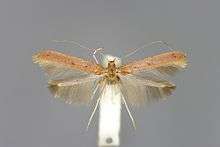Caloptilia elongella
| Caloptilia elongella | |
|---|---|
 | |
| Caloptilia elongella | |
| Scientific classification | |
| Kingdom: | Animalia |
| Phylum: | Arthropoda |
| Class: | Insecta |
| Order: | Lepidoptera |
| Infraorder: | Heteroneura |
| Family: | Gracillariidae |
| Genus: | Caloptilia |
| Species: | C. elongella |
| Binomial name | |
| Caloptilia elongella (Linnaeus, 1761)[1] | |
| Synonyms | |
| |
Caloptilia elongella (commonly known as pale red slender)[2] is a moth of the Gracillariidae family. It is known from all of Europe east to eastern Russia. It is also found in North America from British Columbia, south to California and east in the north to New Hampshire and New York.
The wingspan is 14–16 millimetres (0.55–0.63 in). There are two generations per year, with adults on wing in June and again during September, after which they hibernate and reappear in spring.[3]
The larvae feed on Alnus glutinosa, Alnus incana and Alnus minor. They mine the leaves of their host plant. The mine starts with a short gallery, that opens into (and is often overrun by) a silvery epidermal upper-surface blotch with light brown frass. Older mines contract and become en elongate blister or even a tube. Older larvae leave the mine and continue feeding within a downwards rolled leaf margin that is fastened with silk. Pupation takes place in a transparent, yellow-shining cocoon at the leaf margin.[4]
References
- ↑ "Caloptilia elongella (Linnaeus, 1761)". 2.5. Fauna Europaea. July 23, 2012. Retrieved March 24, 2013.
- ↑ "Pale Red Slender". Norfolk Moths. Retrieved March 25, 2013.
- ↑ UKmoths
- ↑ bladmineerders.nl